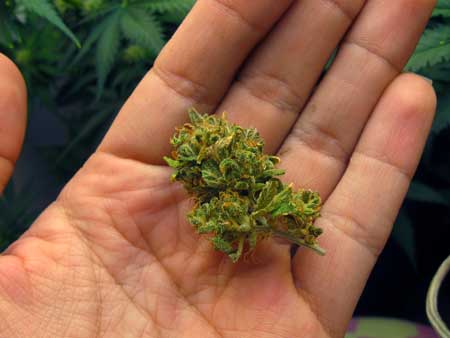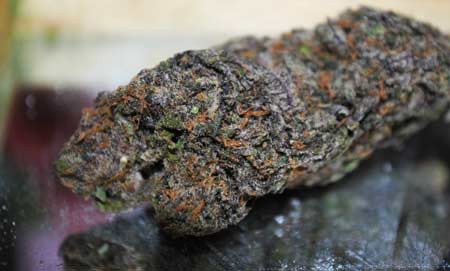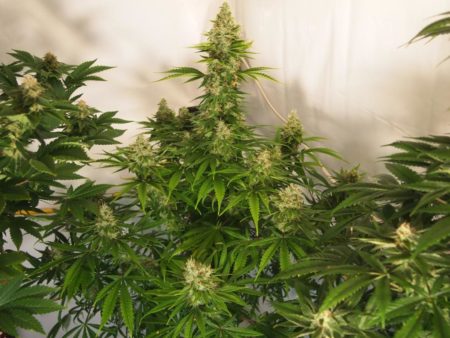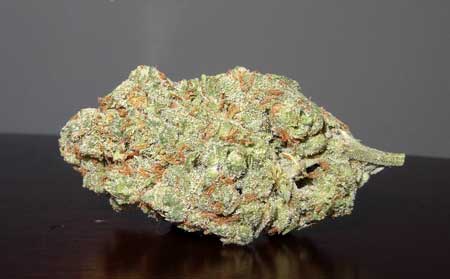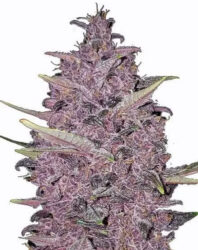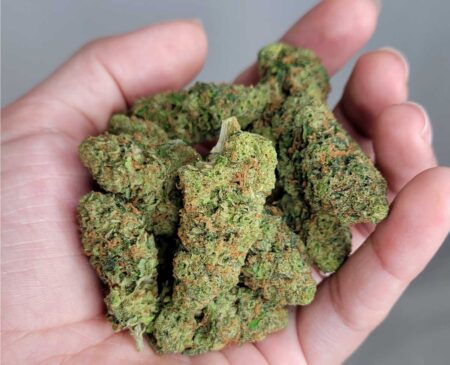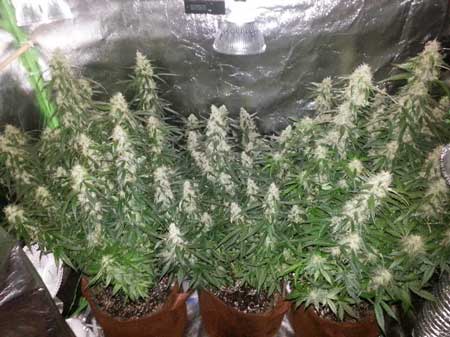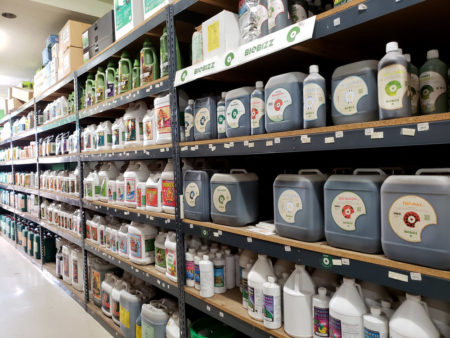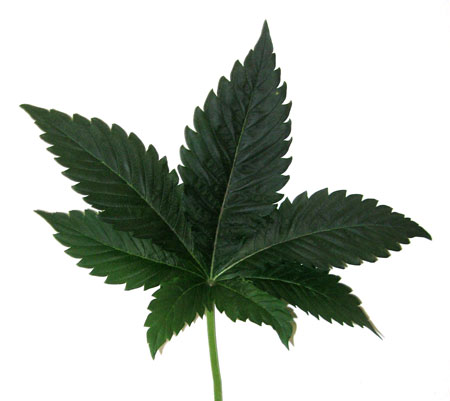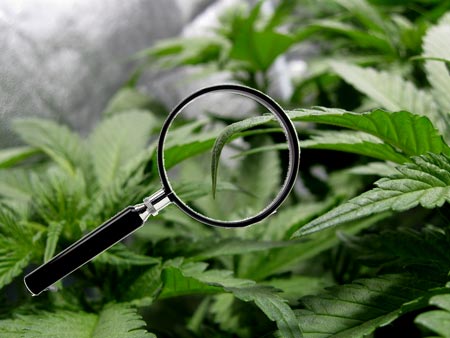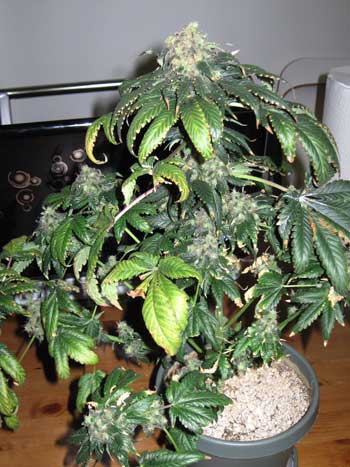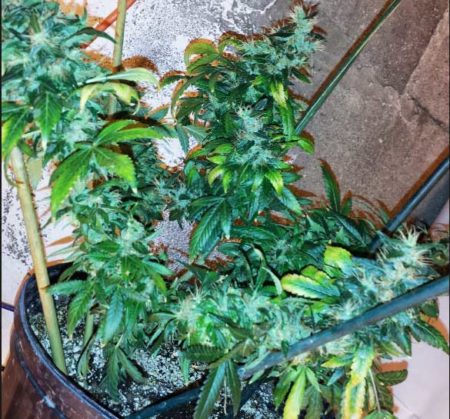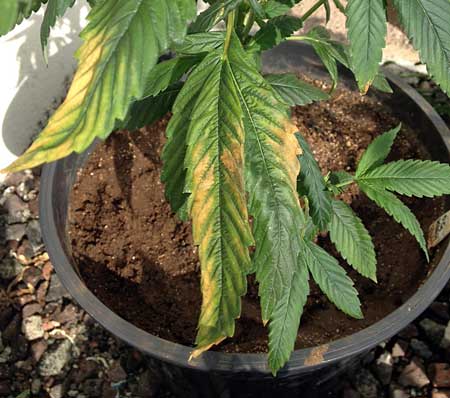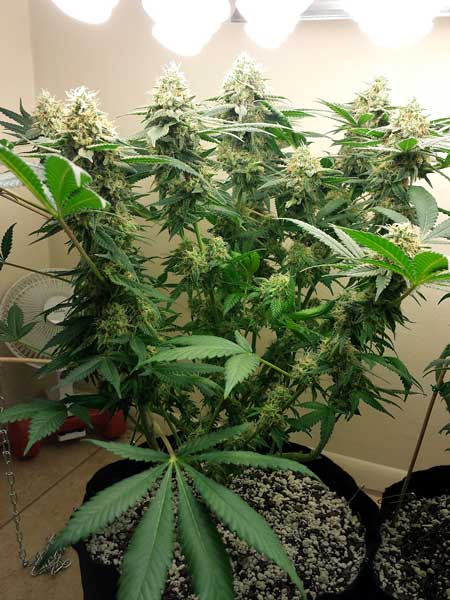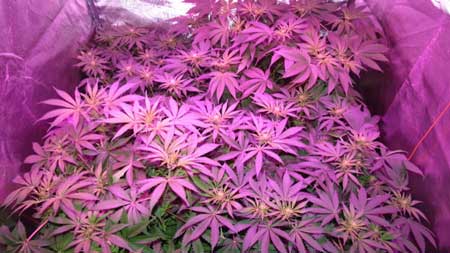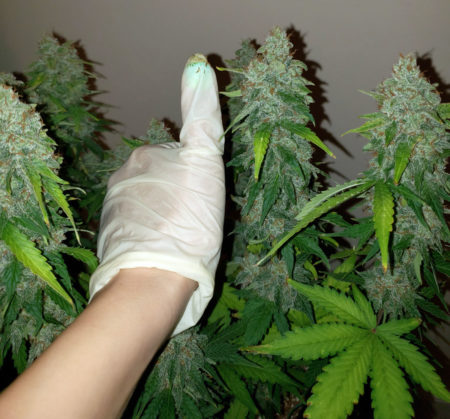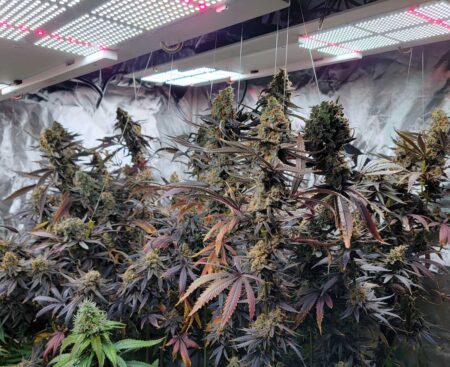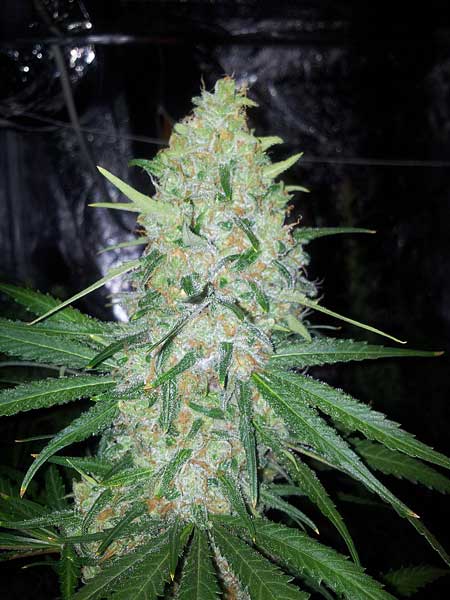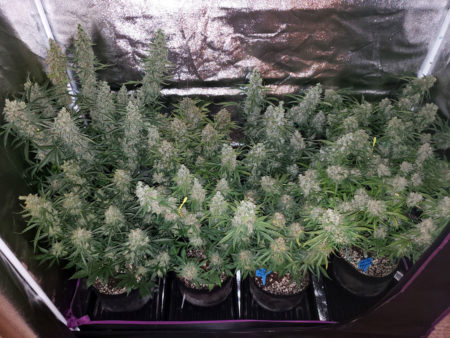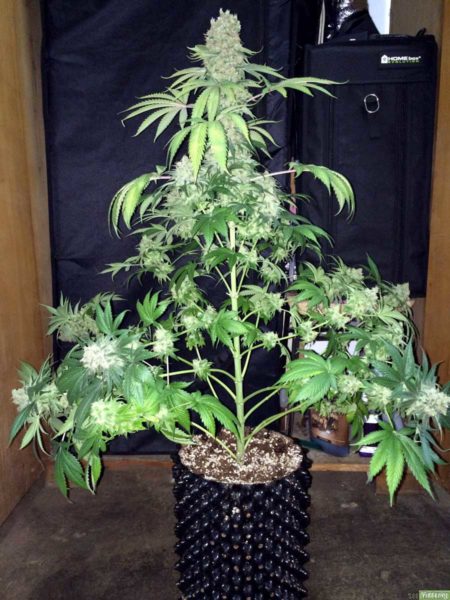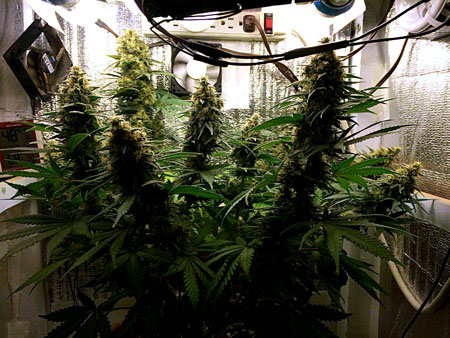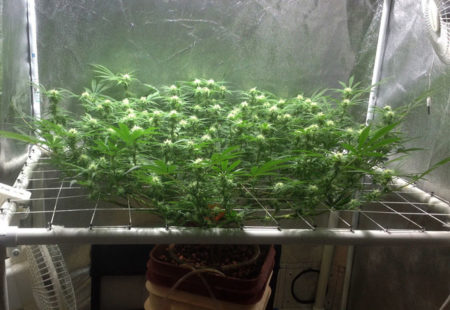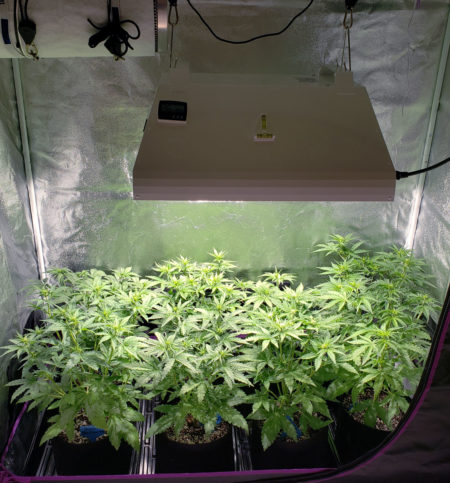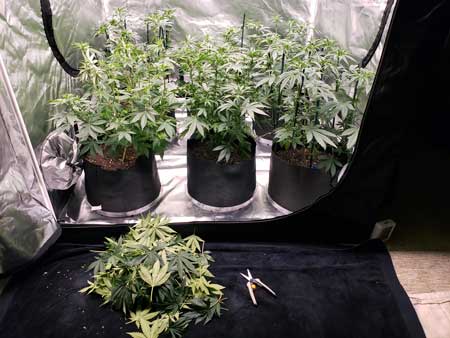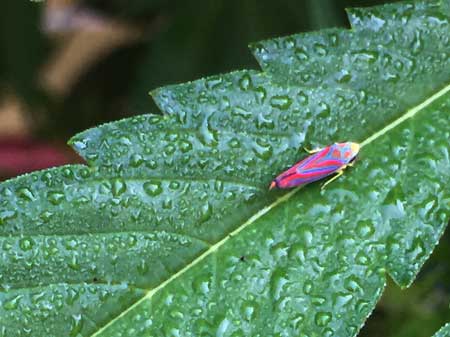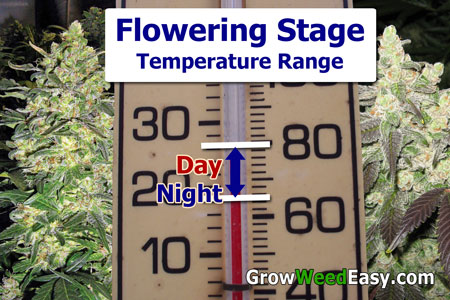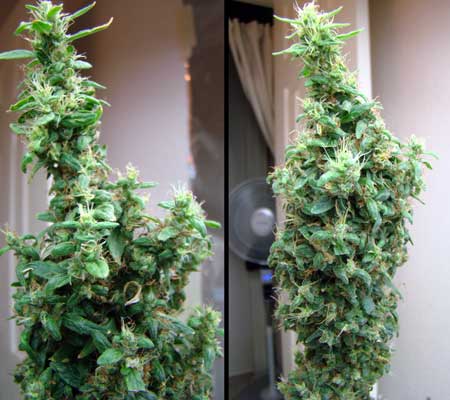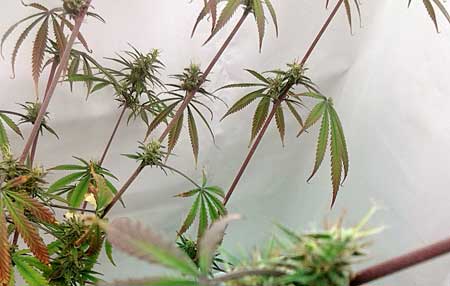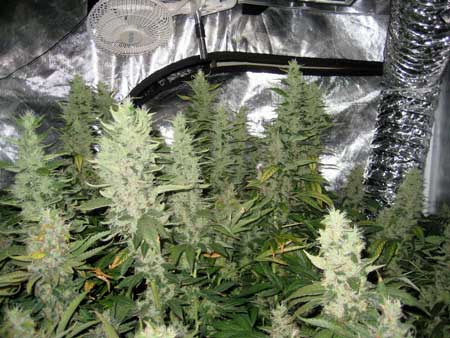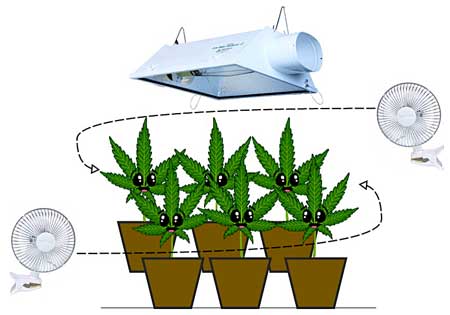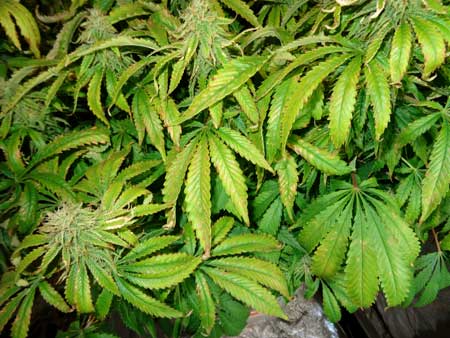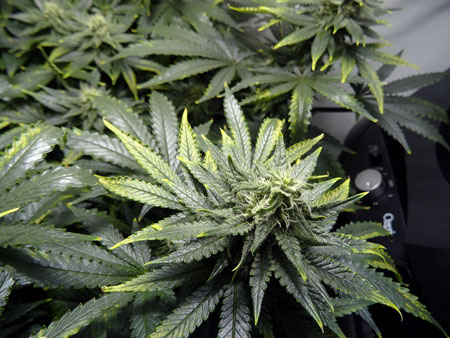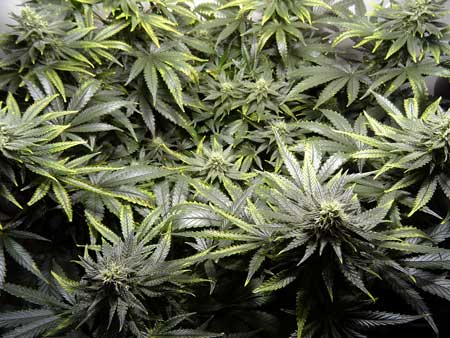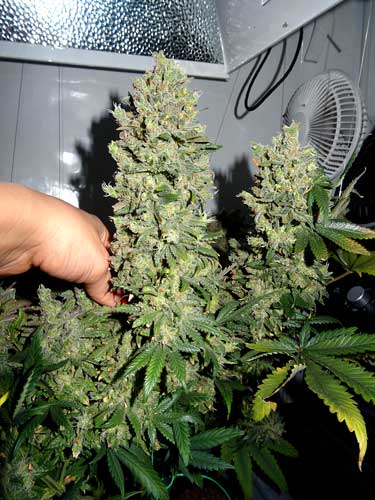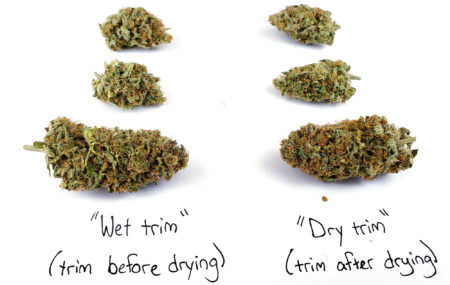by Nebula Haze
Bud density isn’t everything… but it sure is nice! If your cannabis buds keep coming out light and fluffy and you’re not sure why, this article will break it down for you. Learn exactly how to grow the densest, most rock hard cannabis buds possible.
Example of dense marijuana buds. Looks and feels solid.
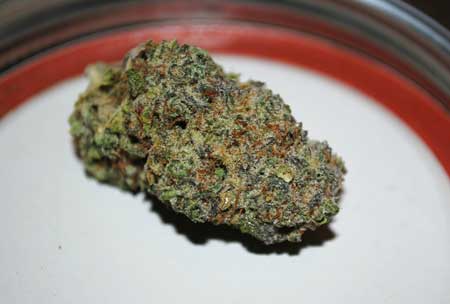
Why do cannabis growers want dense buds?
Dense buds have many advantages:
- Potency – Dense buds tend to have higher levels of THC than looser buds from the same plant. This isn’t always the case, but the same principles that make buds dense (being located at the top of the plant, bright light, good growing environment, vigorous plants, etc.) also tend to raise THC levels. As a result, on average, the densest buds on a particular plant tend to be some of the most potent buds on that plant.
- Weight – If all your buds are dense, that will greatly increase the overall yield weights at harvest. This means each harvest will give you more weed so it either lasts longer or leads to higher profits/savings. As another advantage, you can fit much more weed in less space when the buds are dense.
- Looks great – Beautiful aesthetics aren’t necessary, but it does put a smile on your face to see your homegrown weed looks amazing. In general, dense buds are seen as the most visually appealing, though likely that is the result of the fact that dense buds are often some of the best ones to smoke.
- Smoking experience – Dense buds tend to make a smoother and more longer-lasting smoke compared to loose or airy buds. Note: If buds get too dense they can be difficult to work with or grind up. It’s definitely not the case that more density is always better.
Would you like to start growing denser cannabis buds? If so, you’ve come to the right place. There are some extremely common reasons your cannabis buds aren’t growing as compact or dense as they could be, and I’m going to reveal exactly how to fix that today!
1. ) Genetics – The Foundation of Density
You can’t overcome a cannabis plant’s genetics. Some strains will only grow loose or airy buds, even in perfect growing conditions. If the genetics simply don’t make high bud density, it’s not your fault if buds come out fluffy, and there’s not much you can do to change it. That being said, some of my absolute favorite strains have buds that tend to come out with a lower density. Low density doesn’t necessarily mean buds are bad. It’s common with sativa and haze-leaning strains, as well as certain hybrids.
Once you’re smoking the buds, you don’t notice the difference!
Not all good strains are dense – I personally love Liberty Haze for the captivating bud effects and excellent yields, but the buds aren’t necessarily the most dense.
Choosing a strain that’s known to grow dense will considerably increase the chance of producing dense buds. Indica-leaning strains tend to develop the densest buds, though these days, just about every strain is a hybrid.
Grape Ape is a hardy strain that stays short and tends to grow solid buds even in poor conditions (plus the yields and effects are fantastic)
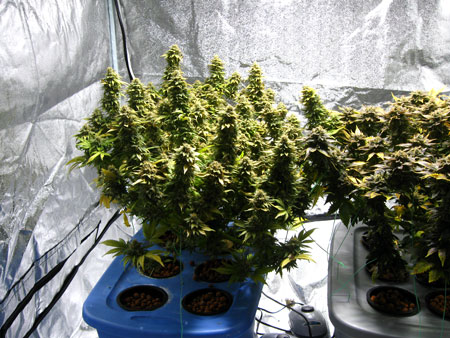
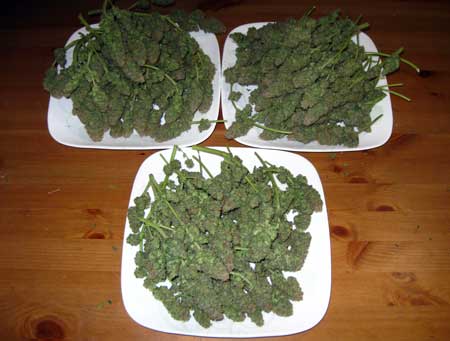
If you’re looking for the highest THC possible, then check out Kushberry Moonrocks, which produces very dense, very potent buds.
Here are more dense strain recommendations:
- Bubba Kush – May be the densest versions of the classic strain, with outstanding effects.
- Somango – Although the buds have strong, psychoactive Sativa-like effects, the plant grows dense buds and has a relatively short flowering period just like an Indica.
- King Kong – Easy to grow strain with great yields, great potency, and tight buds.
- Lemon Cake – A potent strain with big yields and rock hard buds that smell sweet like lemon cheesecake.
- Grape Ape – A fruity “Purps” strain with a dense bud structure and up to 24% THC.
- Cinderella Jack Autoflower – Most dense autoflowering strain I’ve grown so far!
What’s your favorite dense cannabis strain? Let us know and we may feature it in this list!
2.) Feed Me! (Proper Nutrition for Rock Hard Buds)
Cannabis plants tend to be relatively forgiving in the vegetative stage, and the exact nutrients provided don’t matter much as long as plants are growing green and healthy. Yet once you’re in the flowering stage and buds are forming, nutrients begin to have a direct effect on your bud quality, density, and yields.
Don’t Let Cannabis Plants Run Out of Nutrients While Buds Form
Don’t rely on regular potting soil for nutrients in the flowering stage. Plants that are grown in the same soil from seed to harvest often use up the nutrients by the time buds start forming. Proper nutrition is crucial for a plant to produce the biggest, densest buds.
Don’t rely on regular potting soil to provide nutrients while buds are forming. Plants need plenty of P&K in the flowering stage.
If you’re already adding cannabis-friendly nutrients in the water, this likely doesn’t apply to you.
However, if you’re not using nutrients, It’s a good idea to supplement your plant with flowering stage nutrients (high in P and K). The exception is when you’re either regularly transplanting into fresh soil, or using a composted, amended soil (which slowly releases organic nutrients throughout the plant’s life). The specific brand of nutrients isn’t nearly as critical as making sure you’re giving the plant what it needs. Learn more about the best cannabis nutrients.
Get quality nutrients to make sure your plants get enough nutrients in the flowering stage
Avoid Too Much Nitrogen in the Flowering Stage
On the flip side, you can give plants too high levels of nutrients. Providing high levels of nutrients overall causes nutrient burn, which is cosmetic and doesn’t have a massive effect on bud density. However, if you’re giving plants too high levels of nitrogen (N) in the flowering stage, it can inhibit bud development.
Too much nitrogen (N) causes dark green leaves. Sometimes they appear almost shiny
A nitrogen toxicity sometimes causes the tips of leaves to claw down
Luckily it’s effortless to tell if your plant has too much nitrogen. The main symptom of a nitrogen toxicity is dark green leaves, and possibly also clawed tips.
Too much nitrogen in the flowering stage can suppress bud development
A nitrogen toxicity is super easy to fix. Just reduce the amount of nitrogen your plants are getting. Don’t stop giving nitrogen altogether though, pull it back.
If you’re using all-purpose or vegetative nutrients (which are high in nitrogen), you need to find different nutrients. Suitable nutrients for the flowering stage are typically labeled as “Bloom” nutrients and contain low levels of Nitrogen. If you’re using nutrients with multiple bottles that you combine according to a nutrient schedule (like the General Hydroponics Flora trio or the Fox Farm trio), you don’t need to worry. The schedule will automatically decrease the amount of Nitrogen during the flowering stage.
Buds don’t develop as well as they could when a plant is getting too much nitrogen
What if you’re using Bloom nutrients with low nitrogen, but plants still look dark?
In this case, reduce the nutrient levels overall. Don’t change the ratio. You can use fractions to figure out how much nutrients to add (for example trying to cut the nutrients by a 1/3), but I don’t like doing fractions. It’s too easy for me to mess up! Instead, I add extra water after mixing nutrients to dilute the overall levels without messing with the proportions.
When treating a Nitrogen Toxicity, make sure that you give enough water to get some runoff. Runoff water helps flush out any nutrient buildup in the grow medium.
Learn more about nitrogen toxicities
Don’t Ignore Nutrient Deficiencies
Now you know that flowering cannabis plants need plenty of Phosphorus and Potassium (P&K), but not much Nitrogen (N). The next most common nutrient challenge in the flowering stage is the appearance of nutrient deficiencies. If you’re not adding nutrients in the water, there’s a chance that the plant needs higher levels of nutrients overall, and supplementing with a suitable Bloom nutrient will solve the problem.
Not sure which bloom nutrient to get? Dyna-Gro Bloom is an affordable and effective bloom nutrient for cannabis in any grow medium that will provide your plant with complete flowering stage nutrition in any grow medium. An easy way to prevent flowering stage deficiencies!
However, if you’re already using nutrients and still see a nutrient deficiency, it’s likely caused by incorrect pH at the roots.
Don’t ignore nutrient problems like this potassium deficiency! Keep plant leaves as healthy as possible in the flowering stage for the best bud development.
Why should you care about nutrient deficiencies?
Although P&K are most important to bud development, your plants need a variety of nutrients to complete normal plant processes. Any time you ignore a plant that’s getting sick, you’re lowering the overall growth rates and potentially reducing bud size and density.
Diagnose my nutrient deficiency!
What About Supplements?
What about plant supplements? How important are they to bud density?
The truth is, you can achieve incredible bud quality and density using just base nutrients. They contain everything your plant needs for healthy growth, and so you don’t need any supplements to grow great buds. When I first started growing, I felt confused because it seemed like you need supplements to produce brag-worthy buds and yields. I’ve learned over the years that nutrient companies want you to believe that because that helps them sell more bottles. I’m not saying that supplements don’t provide benefits, I just want to assure you that they’re not necessary. They can sometimes make things more complicated by interacting with your nutrients or each other. Many supplements can be useful in small doses but may kill your plants at higher doses, so give sparingly at first to see what effect they have.
Some supplements claim to increase the density of buds, but it’s hard to pin down exactly which ones work. Unfortunately, there are not many side-by-side experiments showing the difference that each supplement makes. Here are some popular choices.
These supplements claim to increase yields and density with extra Phosphorus (P) & Potassium (K)
- Liquid Koolbloom (by General Hydroponics)
- Hydroplex (by Botanicare)
- Beastie Bloomz (by Fox Farms)
Tips for using supplements in the flowering stage
- Only add one new supplement at a time. You’re most likely to have unexpected results if you add several new things at once.
- Adding just one supplement at a time also helps you pinpoint which supplement is causing the effects you see.
- Always use supplements made by the same company as your base nutrients. Sticking with one company reduces the chance of unwanted interactions. Each company designs its nutrients and supplements to be used together.
- Use any supplement sparingly. A little usually goes a long way! Too much of certain supplements can harm plants, burn the leaves, or stunt bud growth. Always start at the lowest recommended dose (or less) and only increase if plants seem to be responding well.
We all want magic in a bottle, but it’s important to remember that the environment and overall plant care are much more critical to achieving excellent bud quality and yields than any particular supplement. You can’t overcome a bad growing environment no matter what you give your plants (more on that next).
Learn more about cannabis plant supplements
3.) Intense Light Makes Dense Buds
Since intense light is key to growing dense buds, the grow light you choose is key to improving density.
Unfortunately, some cannabis grow lights struggle to grow dense buds no matter what you do as a grower.
Grow lights that are excellent at producing high bud density:
- My list of the current best LED grow lights for growing cannabis – Most growers would be happiest with an LED grow light.
- HPS grow lights – These are good lights but they get extremely hot, so they’re best suited for growers with a cold grow room.
- LEC/CMH grow lights – Overall similar to HPS..
Fluorescent lights like T5s can produce dense buds when you keep the lights close. However, the lower buds on plants grown under fluorescents are typically on the fluffier side because the light doesn’t penetrate far into the plant. If density is most important to you, fluorescent lights are not be the best choice.
Fluorescent lights like T5s tend to make fluffy buds. Not the best choice for the best cannabis bud density.
Specific LEDs (especially the no-name ones) have low penetration down into the plant and buds simply don’t harden up.
Low-quality LEDs often produce airy buds. These buds were grown under cheap LEDs. They stayed small and larfy even though plants looked happy and healthy. If the LED looks “blurple” colored, it is typically not well suited to growing cannabis plants.
If density is the most crucial factor for you, generally, you’ll get the best results in the flowering stage with powerful modern LEDs or HID (“big bulb”) lights like HPS. However, the technology for LEDs has improved dramatically in the last few years, and there are many modern models of LEDs that consistently produce long, dense buds.
High-quality LEDs tend to cost a bit more, but the results can be worth it. For example, you can achieve impressive density and yields from LED models like the HLG Quantum Boards (HLG 100 3000k version, HLG 350R, HLG Blackbird, etc.) as well as Spider Farmer and Mars Hydro LED grow lights. Learn more about the best LED grow lights for cannabis.
Certain LEDs produce high density. The HLG 100 (3000k version) uses only 100W and made these extremely dense buds for me.
I’m currently flowering several plants under the HLG 350R, and so far, I’m even more impressed.
HPS grow lights consistently produce dense buds as long as plants are healthy and kept from being hot. However, HPS grow lights produce a lot of heat, and hot air makes fluffy buds. That means HPS grow lights are best suited for a cold grow room. If you’re battling heat, HPS don’t perform nearly as well as LEDs.
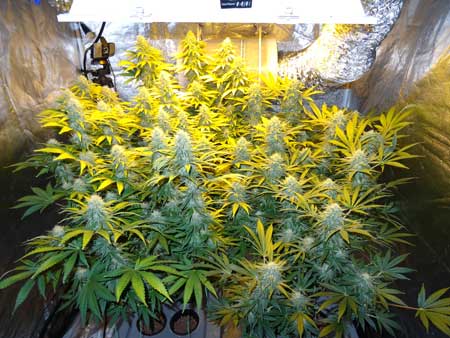
LEC/CMH grow lights also tend to produce dense buds. One of my favorite aspects of growing with an LEC is buds come out extremely sparkly and stinky compared to other grow lights.
These sticky, dense buds were grown under a 315 Ceramic Metal Halide.
4.) Vegetative Stage – Prepare Plants to Make Dense Buds
During the vegetative stage, you have total control over a cannabis plant’s final shape and size. You can use this to your advantage. Set your plants up correctly now so they naturally tend to grow dense buds later.
Grow More Than Just One Main Bud
You can increase your overall yields by training your plant in the vegetative stage (with techniques like LST or manifolding), so it grows multiple primary buds instead of one.
Cannabis plants naturally tend to grow one main bud.
However, growers can use simple techniques in the vegetative stage. often called “plant training” or “plant pruning” that will force the plant to grow many buds in the flowering stage.
Plant training increases yields by forcing plants to grow multiple main buds instead of just one.
Avoid Too Many Bud Sites
However, if you grow a plant with tons and tons of buds sites, it may not be able to fatten them all up before harvest. This is most likely to happen on smaller plants, younger plants, and when using smaller grow lights. If you’ve got a relatively small plant, try to force the plant to focus on just a few main buds instead of dozens. A general rule of thumb is that plants under 2 feet tall should have 4-10 primary buds. Big or wide plants can support more.
Don’t spread the plant’s energy too thin or you may end up with tons of baby “popcorn” buds.
This plant has too many bud sites for its size. Although it may get good yields, none of the buds will grow particularly big or dense.
Bigger plants, older plants, and manifolded plants can support more big, dense buds. Especially when combined with a powerful cannabis grow light.
Don’t Switch to Flowering Stage Too Early
This is sort of related to the last point. Bigger plants can support bigger buds, and switching to 12/12 early means that your plant might not get big enough to make dense, thick colas/buds.
Try to switch to the flowering stage when your plant has reached about half the final desired size. Since plants about double in size after they start getting 12/12, this should give you the biggest plants possible for your grow space.
Switch to 12/12 when plants are half the final desired height. This helps ensure they’re big enough to support dense buds
5.) Flower Power – Create the Perfect Bud-Building Environment
The flowering stage is the most essential part of your plant’s life when it comes to bud quality, density, and yields. The way buds form is a direct reflection of their growing conditions. A common cause of airy buds is poor care or environment while the buds are forming. Here are several factors that can affect whether you get the best bud density in the flowering stage.
Avoid Ultra-leafy Plants While Buds are Forming
Problem: Plants are so leafy that air and light can’t get through the plant. Buds are covered by leaves so they aren’t getting direct light.
Result: The buds don’t get as dense as they could.
These plants are too leafy for the flowering stage. Buds won’t fatten far into the plant, and won’t be as dense as they could be.
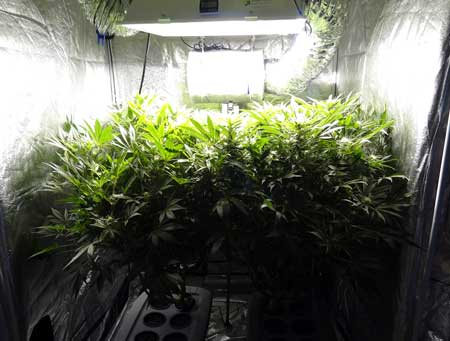
You may need to remove leaves if cannabis plants get too leafy in the flowering stage.
Not sure if your plants are too leafy?
This 3-step defoliation tutorial ensures your plants have the perfect amount of leaves.
Don’t ignore pests or disease
I mentioned nutrient deficiencies already, but it’s also vital that you react immediately to any other issues that may come up. Don’t ignore a problem until it gets out of control.
Typically a sick cannabis plant is simple to treat when it’s just starting to experience problems, but the longer it goes on, the worse it gets. An unhealthy plant won’t grow buds as well as a healthy one, so stay on top of your plant’s health.
Don’t ignore problems like pests or disease.
Avoid extreme temperatures (especially heat)
A lot of growers ignore issues with the plant’s flowering stage environment. Growers often don’t realize how much this can hurt their bud density, potency, and yields. It’s easy to ignore environmental problems like heat because typically, your plants and buds will still be growing.
If plants look okay, the heat should be fine, right? Unfortunately, no.
When the air is too warm (above 80°F/26°C) in the flowering stage, buds tend to grow more light and airy. Sometimes buds even grow unsightly foxtails as a result of heat.
Buds get less dense when it’s too hot. Look at the loose structure of this bud grown in extreme heat.
Too-cold air can also cause buds to grow small, airy, and loose.
Another thing about temperature: cannabis plants in the flowering stage like it to be a little warm in the day, but cool at night. Warm nights are also associated with airy buds. Try to keep the temperature consistently between 65-80°F (18-27°C) for the best bud development in the flowering stage.
Check out our complete cannabis temperature tutorial.
High humidity makes buds grow loose
Humidity in the flowering stage is another factor that’s often ignored. Each plant leaf is constantly adding moisture in the air, which means that the humidity tends to rise in the grow space as plants get bigger. What’s ironic is that cannabis plants like high humidity when they’re young/small, but it causes problems in the flowering stage after buds start forming.
High humidity can trigger bud rot and powdery white mildew, which is plenty enough reason to control humidity. But there’s more. Buds don’t get as sparkly as they could in high humidity, and buds overall tend to grow more loose and airy when the air is humid.
Keep humidity under 50% RH while buds are forming for the best results.
Check out our full cannabis humidity tutorial.
Keep humidity under 50% RH while buds are forming, or they may not get as dense as they could
Give tons of fresh, moving air
Buds seem to fatten the best when they get plenty of light and fresh air. You’ve already taken care of light, but you should also ensure your plants get excellent airflow. Air circulation helps control humidity, prevent wet spots, and moves air through the plant and around the buds.
Check out the full Air-Circulation and Exhaust Tutorial.
Make sure cannabis plants get fresh air and good airflow.
Avoid major stress or deficiencies
If your cannabis plant doesn’t “look good” or seems sickly in the flowering stage, that’s the first thing you should focus on to improve the bud density at harvest.
If plants look generally unhealthy, you should focus on fixing that before trying anything else. These plants are suffering from heat stress. Look how loose the buds are.
Buds tend to stay small and fluffy on an unhealthy plant.
Diagnose your sick cannabis plant here!
6.) Don’t Rush the Finish – Proper Harvesting and Curing
Don’t harvest too early
Buds gain a lot of size, weight, and density during the last few weeks before harvest time. That means if you harvest your cannabis plants a few weeks early, the buds will be significantly smaller and less dense than they could be. Early-harvested buds also aren’t as potent and may give some people a headache. There are lots of great reasons to harvest your plants at the right time.
Learn the exact right time to harvest your cannabis plants.
Don’t harvest until cannabis plants are ready. These buds are dense and ready to harvest!
Always dry and “cure” your cannabis buds
Drying and curing buds makes them smoke better, smell better, feel more potent. Don’t skip this step!
As a bonus, drying and curing can help tighten buds up for that “California dispensary” look.
How to dry and cure your cannabis buds.
Buds tend to look more “tight” and feel denser after being dried and cured
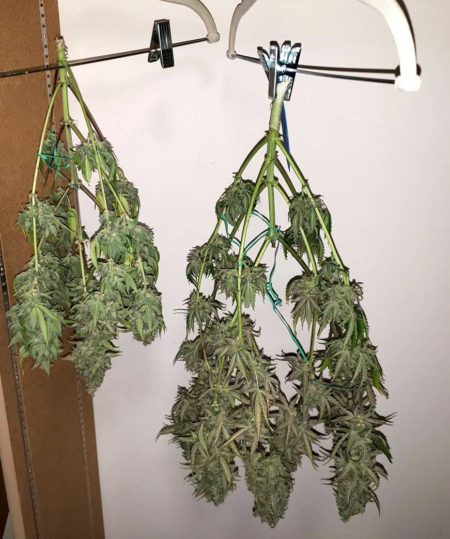
If you avoid these mistakes, you will produce cannabis buds as dense as you’ve always dreamed!

